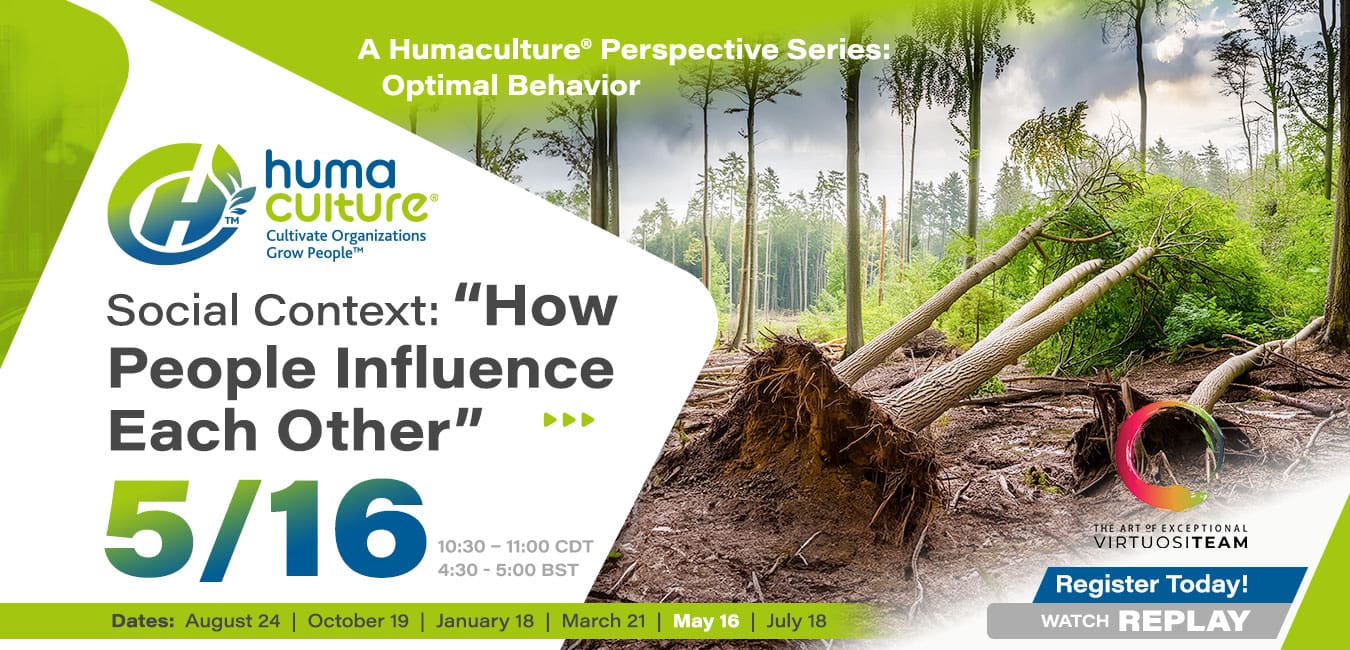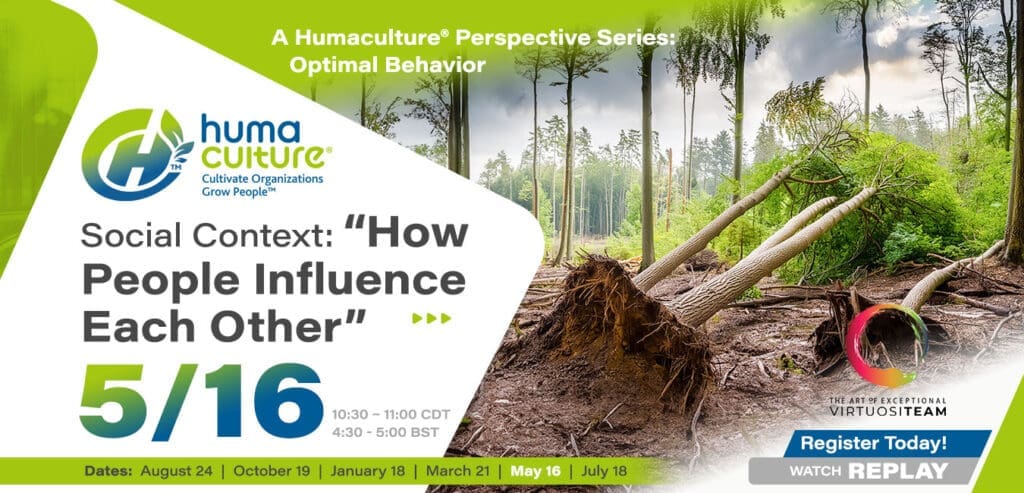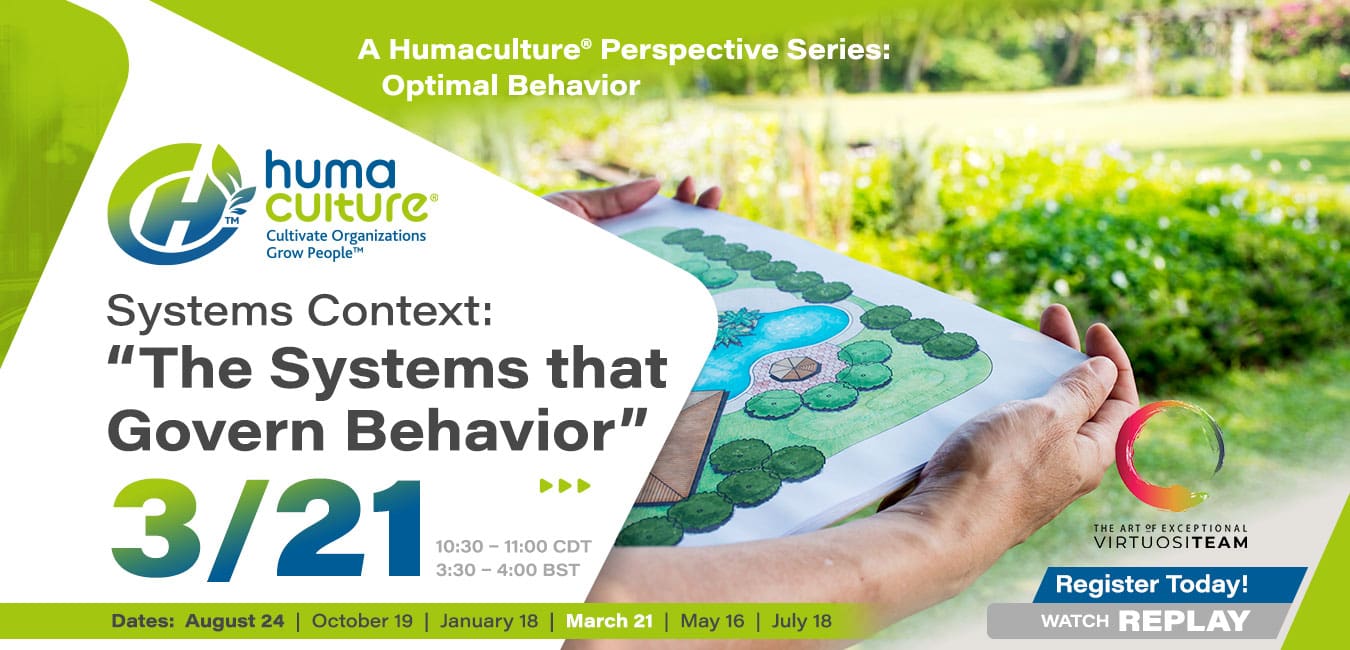Category: Organizational Development
People Development: A Humaculture® Perspective Series
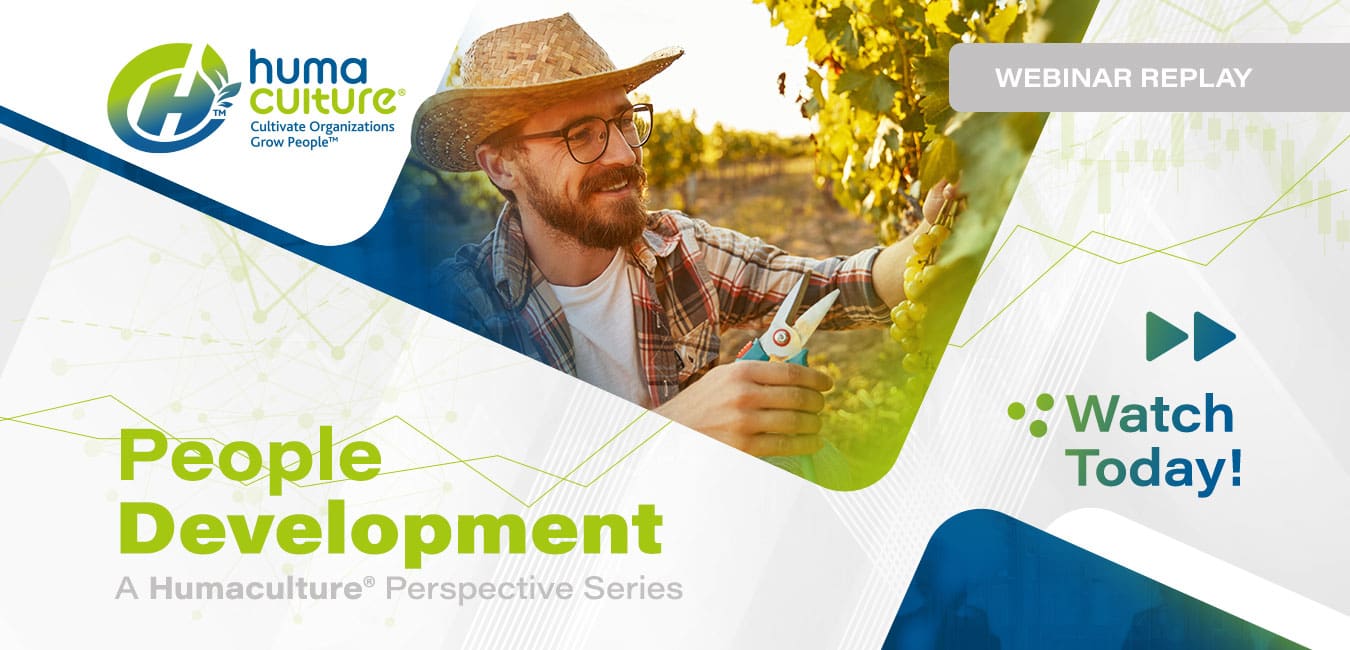
People Development Overview
In this webinar series, we explored ways organizations can rethink the traditional performance management and people development processes to make them more meaningful, impactful, and aligned with the organizational vision and strategy – focusing employees and leaders on what is truly important.
Successful horticulturists recognize the overwhelmingly positive impact of pruning. Pruning is the process of removing branches that:
- Are not supporting the desired shape of the plant the horticulturist seeks,
- Take energy from the plant that reduce productivity,
- Shade or otherwise interfere with the productivity of the other branches.
Effective pruning allows the plant to focus its energies in the most effective and productive areas. People, like plants, often expend energy and time in areas that distract them from achieving their highest and greatest purpose and contributions. In any organization, it is important to help employees remove or overcome the impediments that hold them back, and focus on the areas and interests that will really help them achieve their goals, as well as the strategic priorities of the organization. This series highlights several ways organizations can be innovative and more effective than traditional “performance management.”
The topics from the series include:
| Performance Management: Walking the Garden |
| The shift from Managing to Facilitating Growth |
| Shaping Talent for Success: Pruning the Vines |
| Capabilities: Prune to Encourage Growth |
| Career Planning: Effective Pruning Bears Fruit |
| Employee Development |
| Manager Development |
| Leadership Development |
Available Support
We are available to support you in your strategy, design, compliance, financial, and monitoring needs. To that end, our team of consultants, including actuaries, clinicians, behavioral health, pharmacy, and legal resources are available to guide you through the compliance process. Please contact us.
Optimal Behaviors: Making Optimal Behavior the Natural Choice
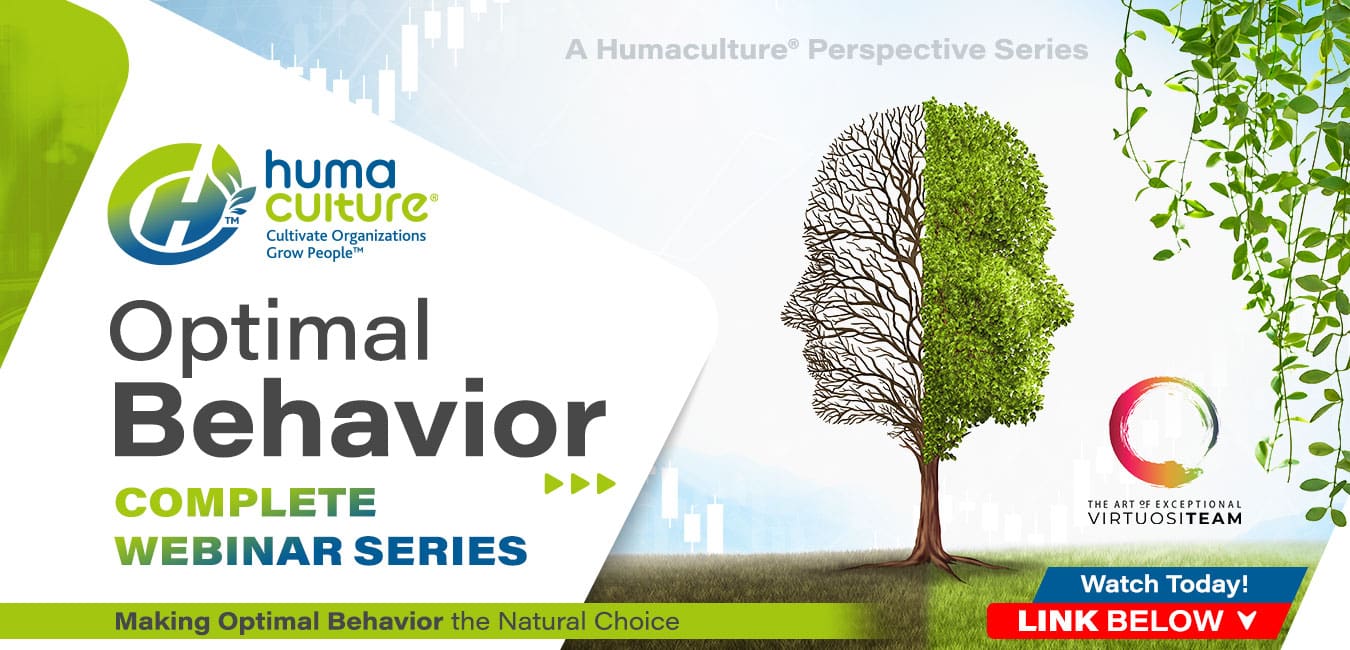
Optimal Behaviors Overview
Watch this webinar series to see how we explore ways organizations can incorporate research-based, practical approaches to create the conditions where Optimal Behaviors are the natural choice. Optimal Behaviors are those that are the most beneficial to the individual as well as the organization.
Horticulturists consider the impact of the conditions in which plants are grown (e.g., climate, soil structure, space and fertility, arrangement, companion planting). Growth and productivity improve when the context of each dimension is appropriately addressed. Expertise from fields like botany and soil sciences provide the successful horticulturist with the information to do their jobs well.
Similarly, Humaculturists® consider the Seven Dimensions of Humaculture® to employ knowledge solidly “rooted” in science for the best results. Behavioral Research Applied Technology Laboratory (BRATLAB), Virtuositeam’s research arm, set out to answer some crucial questions related to understanding changes in behavior and habit creation:
- Which habits really matter, and to what degree, to the three biggest hidden drivers of sustained performance at work, human health, happiness, and security?
- How do we support people to practice these habits in a way that they experience as easy and natural, and that leaves them feeling highly engaged with their employer?
Four Powers Model of Change
The result: the Four Powers Model of Change. This model helps organizations create a thriving culture by leveraging this key distinction: how people THINK they behave and make decisions, versus how they ACTUALLY behave and make decisions. Four Powers is based on behavioral theories and validated research, behavioral research laboratories, and BRATLAB’s own extensive field testing. BRATLAB looked across industries to find the influence techniques that have been successfully used for years to shape employee and customer behavior.
The topics from the series include:
- Introduction: “Creating the Conditions for Optimal Behavior”
- Spaces Context: “Grow a Willow in a Desert? The importance of Spaces”
- Context of the Self: “The Complexity of Each Person”
- Systems Context: “The Systems that Govern Behavior”
- Social Context: “How People Influence Each Other”
- Harvest Time: “Reaping the Fruit of Optimal Behaviors”
Prior Series
- Hidden Opportunities, A Strategic Compliance Series
- People Development: A Humaculture® Perspective Series
Available Support
We are available to support you in your strategy, design, compliance, financial, and monitoring needs. Our team includes experts in organization design, actuarial science, clinical, and legal can guide the process to achieve optimal behavior. Please contact us.
Webinar Replay: Harvest Time: “Reaping the Fruit of Optimal Behaviors”
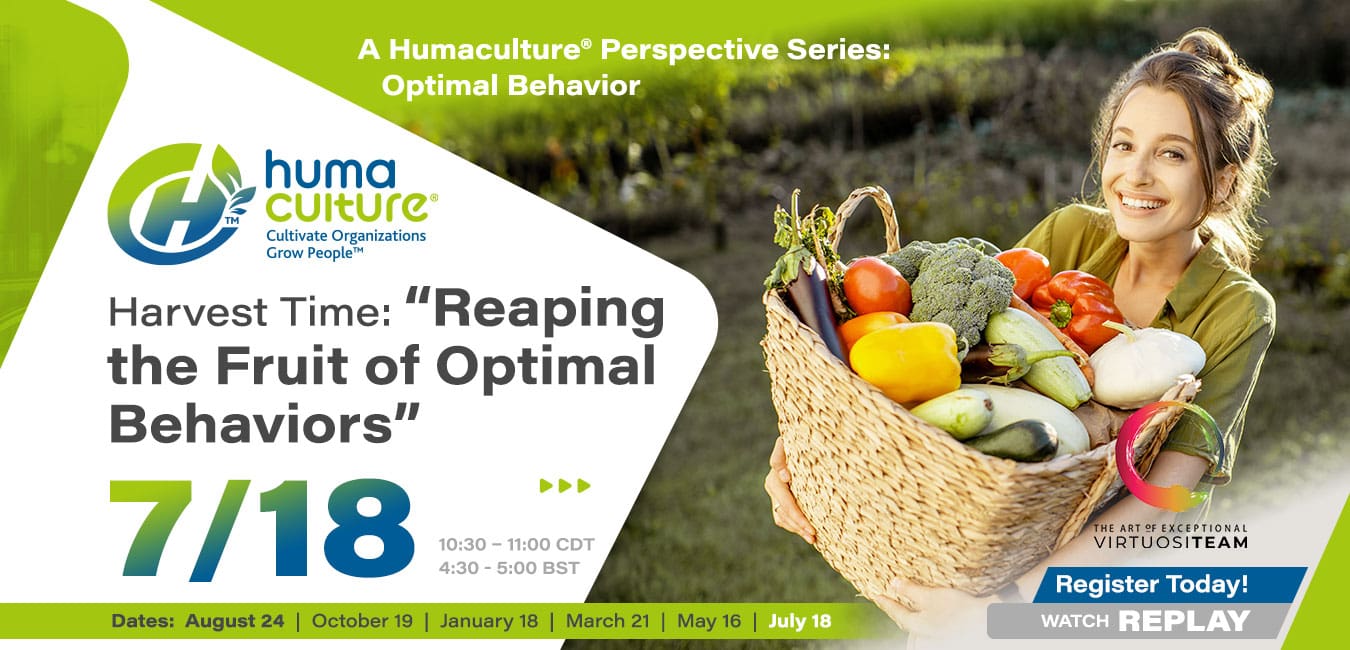
Watch a replay of the sixth and final webinar in Humaculture, Inc.’s “Optimal Behavior: Making Optimal Behavior the Natural Choice” to learn why and how to apply the four Contexts and four Powers of behavior change through a review of a case example.
Presenters
- Steve Cyboran, ASA, MAAA, FCA, CEBS, actuary and strategy consultant
- Wes Rogers, Humaculturist® and strategy consultant
- Colin Bullen, ASA, behavior change actuary
- Hanlie van Wyk, behavior change consultant
Objective
In this sixth and final session in our series on Optimal Behavior, we explore how to apply all the learning from the previous five webinars to reap a bountiful harvest produced by desired behaviors. To reliably achieve sustained Optimal Behavior, we consider all four Contexts – Spaces, Self, Systems, and Social. We do this by applying the Four Powers – the Powers to grow capability, inspire motivation, overcome barriers, and resist temptation – to align the influences acting on People toward supporting the change to Optimal Behavior. We will demonstrate the process of adjusting the Powers within the Contexts and the practical steps to take using a case study in the retail sector. We wrap up with the virtuous cycle that is the Change Ecosystem, showing how to reinforce Optimal Behaviors and ensure those behaviors stick. At the end of this webinar, attendees will understand how the Powers and Contexts come together to create the Four Powers behavior change framework and how that framework can be applied in practice.
“In the final analysis, change sticks when it becomes the way we do things around here.” – John P Kotter
Harvest Time Key Takeaways
Join us to learn how to apply the Four Powers model of change to reap the following fruits:
- Confident and capable People
- Inspired workplace
- Agile workforce
- People armored against distractions
Watch
Watch the Optimal Behavior: Harvest Time: “Reaping the Fruit of Optimal Behaviors” via Rumble or YouTube.

Available Support
We are available to support you in your strategy, design, compliance, financial, and monitoring needs. Our team includes business and human relations leaders, finance experts, actuaries, clinicians, behavioral health experts, pharmacy experts, and legal resources to guide you through the strategy and compliance process. Please contact us: [email protected].
Harvest Time: “Reaping the Fruit of Optimal Behaviors”
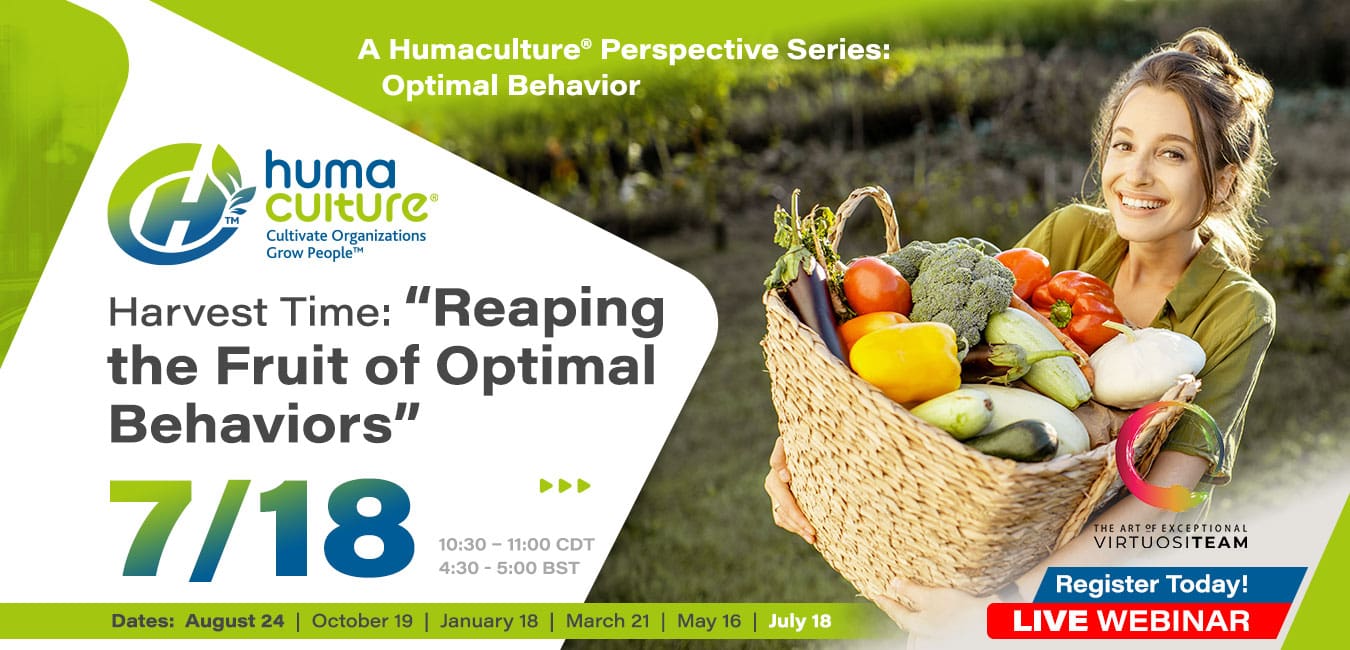
Join us on Thursday, July 18, 2024 from 10:30 to 11:00 CDT (4:30 to 5:00 BST) for the sixth webinar in Humaculture, Inc.’s “Optimal Behavior: Making Optimal Behavior the Natural Choice.” You will learn why and how to apply the four Contexts and four Powers of behavior change through a review of a case example.
Presenters
- Steve Cyboran, ASA, MAAA, FCA, CEBS, actuary and strategy consultant
- Wes Rogers, Humaculturist® and strategy consultant
- Colin Bullen, ASA, behavior change actuary
- Hanlie van Wyk, behavior change consultant
Objective
In this sixth and final session in our series on Optimal Behavior, we explore how to apply all the learning from the previous five webinars to reap a bountiful harvest produced by desired behaviors. To reliably achieve sustained Optimal Behavior, we consider all four Contexts – Spaces, Self, Systems, and Social. We do this by applying the Four Powers – the Powers to grow capability, inspire motivation, overcome barriers, and resist temptation – to align the influences acting on People toward supporting the change to Optimal Behavior. We will demonstrate the process of adjusting the Powers within the Contexts and the practical steps to take using a case study in the retail sector. We wrap up with the virtuous cycle that is the Change Ecosystem, showing how to reinforce Optimal Behaviors and ensure those behaviors stick. At the end of this webinar, attendees will understand how the Powers and Contexts come together to create the Four Powers behavior change framework and how that framework can be applied in practice.
“In the final analysis, change sticks when it becomes the way we do things around here.” – John P Kotter
Harvest Time Key Takeaways
Join us to learn how to apply the Four Powers model of change to reap the following fruits:
- Confident and capable People
- Inspired workplace
- Agile workforce
- People armored against distractions
Available Support
We are available to support you in your strategy, design, compliance, financial, and monitoring needs. Our team includes business and human relations leaders, finance experts, actuaries, clinicians, behavioral health experts, pharmacy experts, and legal resources to guide you through the strategy and compliance process. Please contact us: [email protected].
Social Context: “How People Influence Each Other”
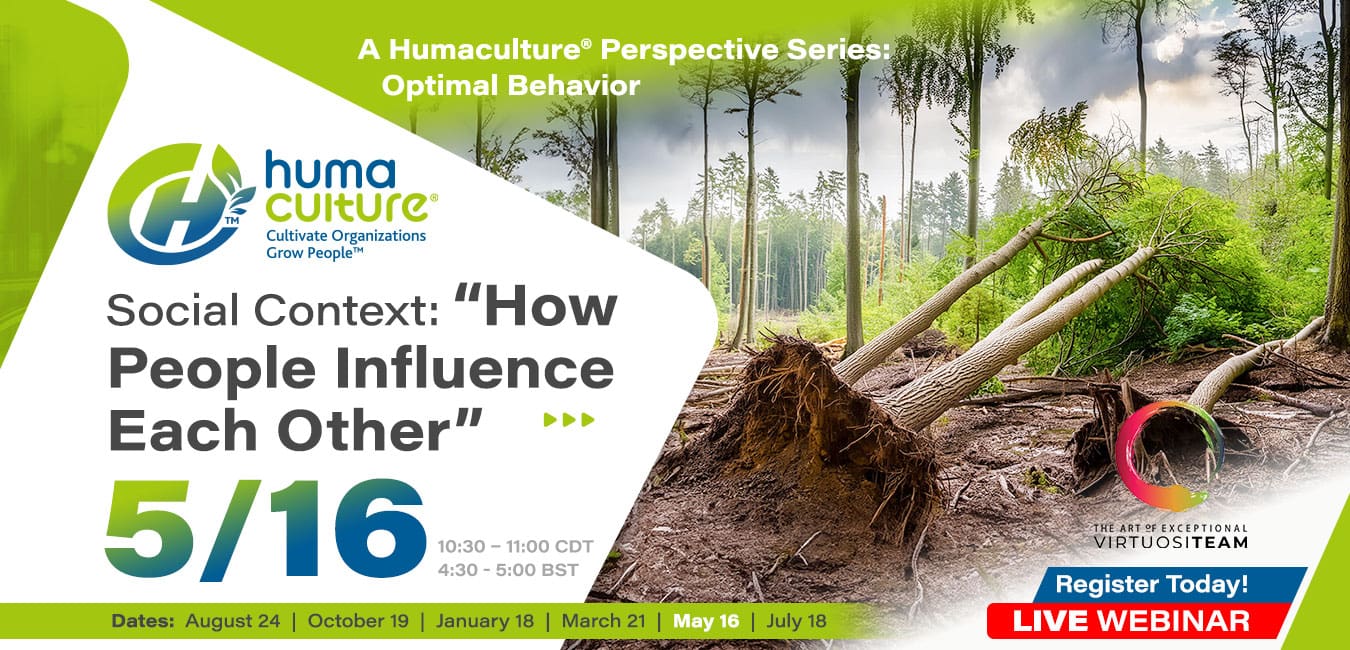
Join us on Thursday, May 16, 2024 from 10:30 to 11:00 CDT (4:30 to 5:00 BDT) for the fifth webinar in Humaculture, Inc.’s “Optimal Behavior: Making Optimal Behavior the Natural Choice.” You will learn why and how the Social Context within an Organization impacts performance and well-being and how it can be used to grow capabilities, inspire motivation, overcome barriers, and resist temptations to lead to Optimal Behavior.
Presenters
- Steve Cyboran, ASA, MAAA, FCA, CEBS, actuary and strategy consultant
- Wes Rogers, Humaculturist® and strategy consultant
- Colin Bullen, ASA, behavior change actuary
- Hanlie van Wyk, behavior change consultant
Objective
In this fifth session in our series on Optimal Behavior, we explore how the Social Context influences behavior and change. To achieve Optimal Behavior, attempts to change require the support of People along the way. The powerful influence of our friends, families, colleagues, bosses, and social connections is around us all the time. In the workplace, change rarely happens unless there are early adopters who visibly engage in the new behavior for others to copy – acting as a role model for the desired Optimal Behavior. These early adopters, who are known by many names including ‘Change Agents’ or ‘Champions’, provide an energy that Inspires Motivation while demonstrating to People like them that change is possible, which builds confidence. Companies successfully moving toward Optional Behavior will connect People to build willpower and make very clear the expectations of everyone involved. Finally, new ways of behaving should be reinforced by creating a new corporate hero archetype who succeeds by demonstrating Optimal Behaviors, not others!
“It was only a sunny smile, and little it cost in the giving, but like morning light it scattered the night and made the day worth living.” – F. Scott Fitzgerald
Social Context Key Takeaways
Join us to learn:
- How ineffective organizations fail to:
- Understand the power of social connection
- Create conditions to make connections natural
- Reinforce the messages to keep people on track
- How effective organizations:
- Leverage social contagion and champions
- Create opportunities for natural interaction
- Celebrate early adopters and share willpower
Available Support
We are available to support you in your strategy, design, compliance, financial, and monitoring needs. Our team includes business and human relations leaders, finance experts, actuaries, clinicians, behavioral health experts, pharmacy experts, and legal resources to guide you through the strategy and compliance process. Please contact us: [email protected].
Systems Context: “The Systems that Govern Behavior”
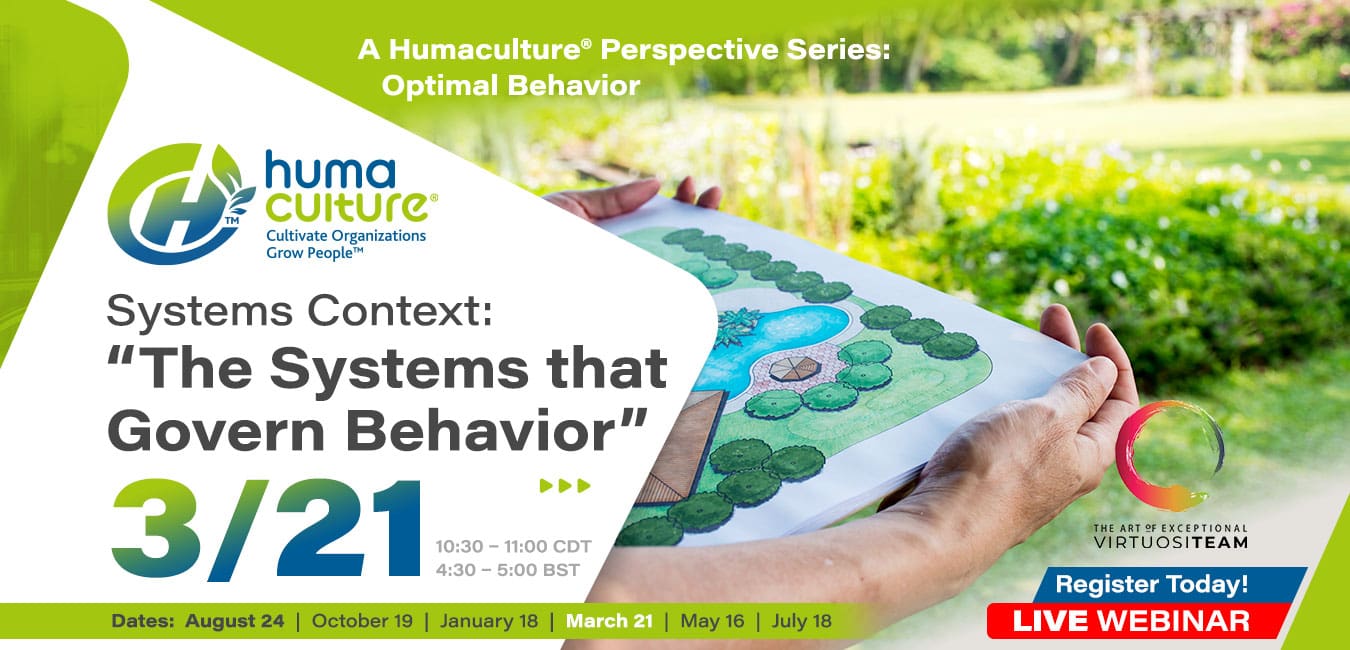
Join us on Thursday, March 21, 2024 from 10:30 to 11:00 CDT for the third webinar in Humaculture, Inc.’s “Optimal Behavior: Making Optimal Behavior the Natural Choice.” You will learn why and how the Systems employed in an Organization impact performance and well-being and how they can be used to grow capabilities, inspire motivation, overcome barriers, and resist temptations to lead to Optimal Behavior.
Presenters
- Steve Cyboran, ASA, MAAA, FCA, CEBS, actuary and strategy consultant
- Wes Rogers, Humaculturist® and strategy consultant
- Colin Bullen, ASA, behavior change actuary
- Hanlie van Wyk, behavior change consultant
Objective
In this fourth session in our series on Optimal Behavior, we explore how the Systems context influences behavior and change. To be able to evolve towards Optimal Behavior, people need to be surrounded by Systems that support them on their journey. The Systems context contains all the tools and guidelines that help us on our way every day. In the workplace these are policies and procedures, enterprise resource management Systems, pay, benefits, and rewards, as well as that curious thing we often refer to as “the way we do things around here.” Anything that signals the optimal way to behave in each Organization. If any of those Systems are misaligned with the Optimal Behavior you’re trying to achieve, your change efforts will fail. The Organizations that recognize this know how to adjust those Systems, including when to bring things into the public eye and when to keep them quiet. They will also be aware that rewards for engagement need to drive intrinsic motivation if the Organization is to develop optimal habits that last.
“A bad system will beat a good person every time.” – W. Edwards Deming
Systems Context to Promote Optimal Behavior Key Takeaways
Join us to learn:
- How ineffective Organizations employ Systems that:
- Limit growth and development
- Lead to discouragement and apathy
- Create unintended barriers or temptations
- How effective Organizations:
- Build habits into processes
- Provide meaningful rewards built on recognition and appreciation
- Balance private correction and open dialogue
Available Support
We are available to support Organizations in the ongoing management of total rewards, compensation and benefit programs including strategy, design, compliance, financial, and monitoring needs. Our team includes business and human relations leaders, finance experts, actuaries, clinicians, behavioral health experts, pharmacy experts, and legal resources to guide you through the strategy, management, and compliance process. Please contact us: [email protected].
Webinar Replay: Context of the Self: “The Complexity of Each Person”
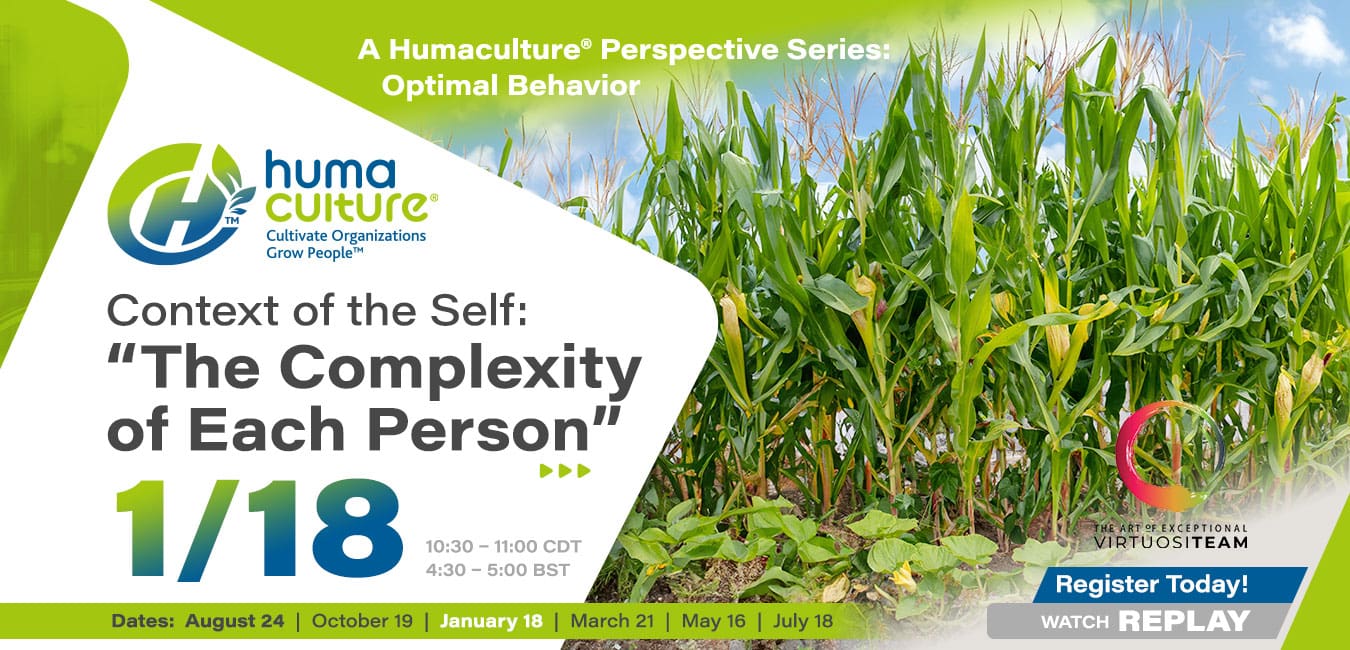
Watch a replay of the third webinar in Humaculture, Inc.’s “Optimal Behavior: Making Optimal Behavior the Natural Choice” to learn why the self can hamper performance and well-being and how to help People to grow capabilities, inspire motivation, overcome barriers, and resist temptations in order to lead to optimal behavior.
Presenters
- Steve Cyboran, ASA, MAAA, FCA, CEBS, actuary and strategy consultant
- Wes Rogers, Humaculturist® and strategy consultant
- Colin Bullen, ASA, behavior change actuary
- Hanlie van Wyk, behavior change consultant
Objective
In this third session in our series on optimal behavior, we explore how the Context of Self influences behavior. To be effective within the Organization, People need to know and manage themselves through their own narrative and understand the same for the People around them. Organizations fail to use narrative stories to connect People to the meaning of changes they are trying to make. Organizations shy away from giving People constructive feedback, yet People need feedback to Grow. Organizations fail to articulate the reason the Organization exists and how People connect with it. To inspire people to perform, Organizational purpose needs to be clear and create emotional attachment, driving motivation. Finally, Organizations associate fun as something that happens outside the workplace and having fun is regarded as unproductive. However, scientists have discovered that it takes approximately 400 repetitions to create a new synapse in the brain, unless it is done in play, in which case it only takes 10 to 20 repetitions.
“The measure of intelligence is the ability to change.” Albert Einstein
Context of Self to Promote Optimal Behavior Key Takeaways
Join us to learn:
- How ineffective organizations:
- Don’t understand how People change behavior
- Don’t Grow Capability and Confidence to change
- Don’t motivate and inspire change
- Don’t recognize how People inhibit sustained behavior change
- How effective organizations:
- Grow competence in change resilience
- Inspire and motivate
- Deploy change sustaining reinforcement tools
Available Support
We are available to support you in your strategy, design, compliance, financial, and monitoring needs. Our team includes business and human relations leaders, finance experts, actuaries, clinicians, behavioral health experts, pharmacy experts, and legal resources to guide you through the strategy and compliance process. Please contact us: [email protected].
Watch
Watch the Career Planning: Effective Pruning Bears Fruit: Manager Development Webinar Replay via Rumble or YouTube.
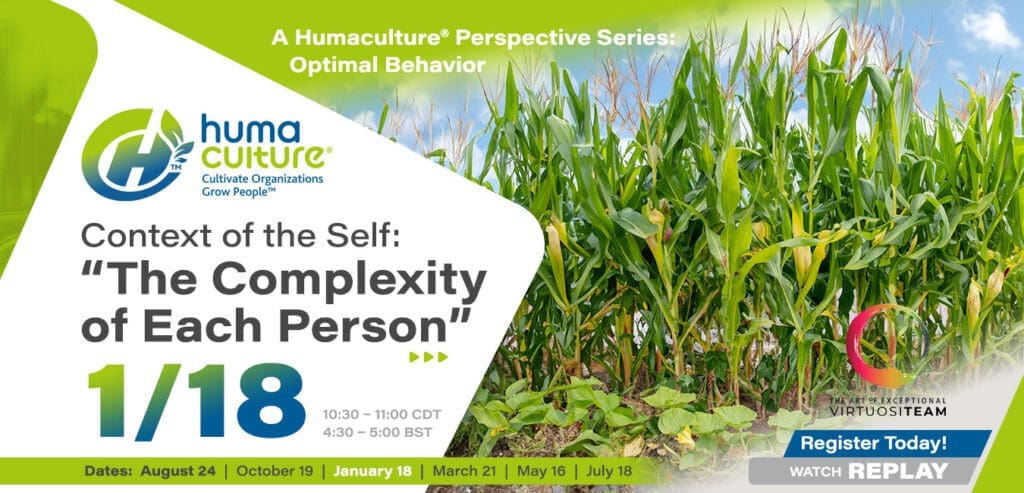
Context of the Self: “The Complexity of Each Person”
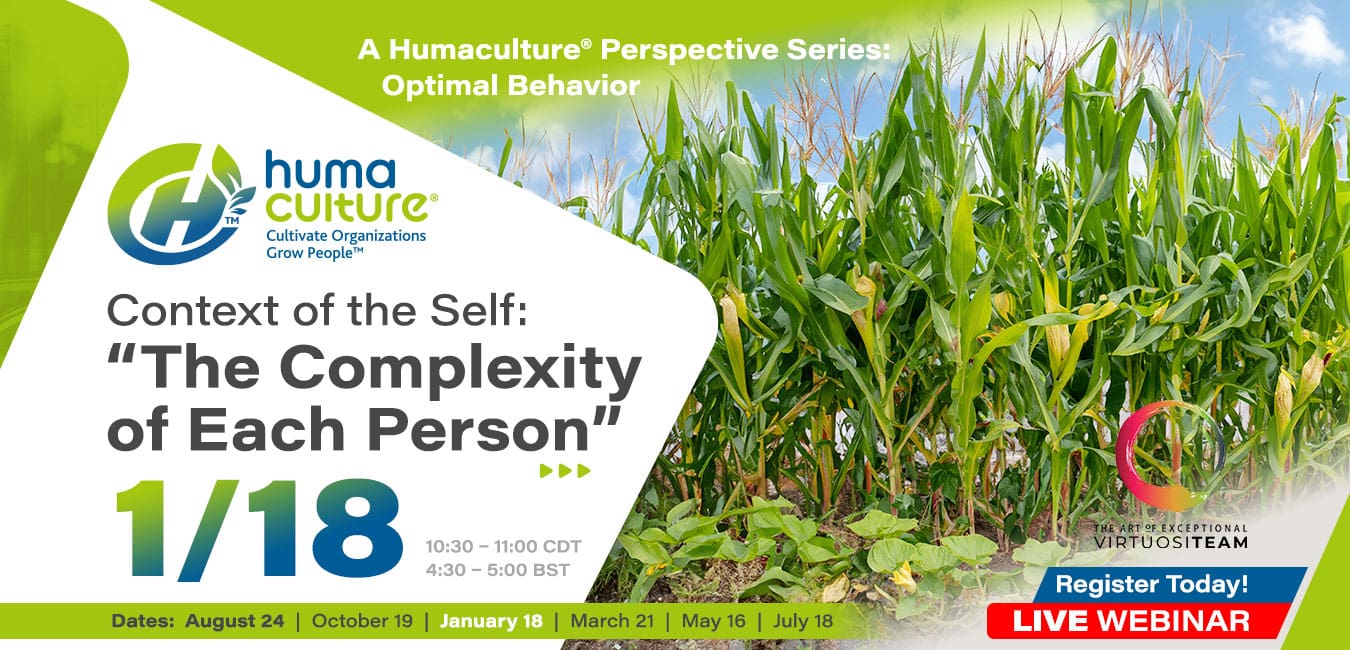
Join us on Thursday, January 18, 2024 from 10:30 to 11:00 CDT for the third webinar in Humaculture, Inc.’s “Optimal Behavior: Making Optimal Behavior the Natural Choice.” You will learn why the self can hamper performance and well-being and how to help People to grow capabilities, inspire motivation, overcome barriers, and resist temptations in order to lead to optimal behavior.
Presenters
- Steve Cyboran, ASA, MAAA, FCA, CEBS, actuary and strategy consultant
- Wes Rogers, Humaculturist® and strategy consultant
- Colin Bullen, ASA, behavior change actuary
- Hanlie van Wyk, behavior change consultant
Objective
In this third session in our series on optimal behavior, we explore how the Context of Self influences behavior. To be effective within the Organization, People need to know and manage themselves through their own narrative and understand the same for the People around them. Organizations fail to use narrative stories to connect People to the meaning of changes they are trying to make. Organizations shy away from giving People constructive feedback, yet People need feedback to Grow. Organizations fail to articulate the reason the Organization exists and how People connect with it. To inspire people to perform, Organizational purpose needs to be clear and create emotional attachment, driving motivation. Finally, Organizations associate fun as something that happens outside the workplace and having fun is regarded as unproductive. However, scientists have discovered that it takes approximately 400 repetitions to create a new synapse in the brain, unless it is done in play, in which case it only takes 10 to 20 repetitions.
“The measure of intelligence is the ability to change.” Albert Einstein
Context of Self to Promote Optimal Behavior Key Takeaways
Join us to learn:
- How ineffective organizations:
- Don’t understand how People change behavior
- Don’t Grow Capability and Confidence to change
- Don’t motivate and inspire change
- Don’t recognize how People inhibit sustained behavior change
- How effective organizations:
- Grow competence in change resilience
- Inspire and motivate
- Deploy change sustaining reinforcement tools
Available Support
We are available to support you in your strategy, design, compliance, financial, and monitoring needs. Our team includes business and human relations leaders, finance experts, actuaries, clinicians, behavioral health experts, pharmacy experts, and legal resources to guide you through the strategy and compliance process. Please contact us: [email protected].

